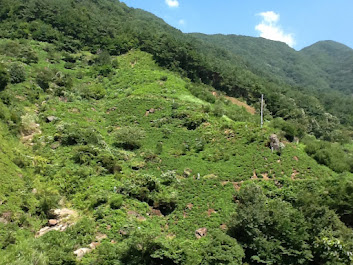Nokcha Simplified
Nokcha, Korea's Green Tea, Simplified
Well here we go, down the rabbit hole in an attempt to explain as simply as possible the green teas or Nokcha we offer at Morning Crane Tea. A rabbit hole because you never know where it will lead. But in this case I'll try to avoid that trap and keep it simple. Did you think that rabbit hole was in the image above? Well in a way it is. Those small bushes are wild tea growing on a rugged hillside near Hadong, Korea. If you look very closely, you will see a few small short white posts placed near these bushes. They are traps for insects as no pesticides are used and no fertilizer. Yes, they are organically grown as are all the teas we offer. In addition, after more than 1000 years all of our teas are from authentic Korean cultivars.
But I'm beginning to digress. I created this post just to explain simply the Nokcha or green tea produced in Korea.
Korean Green Tea Types
Korean green teas are traditionally plucked according to the lunar calendar’s 24 seasonal dates each divided by two weeks and each significant in some way. The most important of these dates are Gogu, Ipha, Soman, Manjong and Haji. Koreans traditionally pluck leaves beginning before Gogu April 20 or 21 until Haji that ends about July 7. Most farmers only produce the first three green teas ending their processing after Jungjak. Some then continue to obtain larger leaves for their balhyochas or oxidized teas.
The tea traditional Nokcha or green tea types are Woojeon, Sejak, Jungjak, Daejak and YipCha.
Woojeon (우전)
This is the first flush of tiny tea leaves. The first 3 and sometimes 2 leaves including the not yet open bud. Plucked before Gogu April 20 or 21 according to the lunar calendar. Sweet, fresh and mellow - delicious.
Gogucha and Muwi Saejak (세작)
Both Muwi Sejak and Gogucha are
early Sejak's plucked on Gogu day and a few more days. Both are rare teas and both are classified as Gogucha. These
leaves are slightly larger than Woojeon leaves and include two leaves and the not yet open
bud. They are the favorite teas of many. The difference is in the production of the two teas we offer. Muwi
is Jeongcha Style immersed into boiling water before hand kneading and roasting. Gogucha is Tteoukeumcha Style or pan roasted alternating with kneading between up to 9 roastings.
Saejak (세작)
Traditionally the Second flush. These leaves are plucked after Gogu Day. While slightly larger than Woojeon and Gogu leaves, the pluck typically includes three leaves including the not yet open bud. These are the favorite tea for many. Like all of our teas there are many nuances in the production that influences flavor. Find your favorite Sejak.
Jungjak (중작)
The plucking of Jungjak leaves, known as the ‘perfect’ leaf, begins with the seasonal date Ipha. Some producers make Iphacha. Three open leaves and a bud that produce a rich flavor profile. It has wonderful color and taste. Don’t neglect these later leaves. You may find them to be your favorite as many of our clients have.
Daejak (대작)
Daejak is made of leaves traditionally collected after the seasonal date Soman. The four leaves are larger and produce abundant flavor. Keep your brews short with more leaves.
Daejak feels neglected like, a middle child, it has not had an outside review. Brewed properly Daejak is, in my opinion, rich and flavorful. Who will give Daejak its first review?
YipCha (잎차)
One Korean tea site said of their "YeopCha", “Mostly consists of hard leaves.” An unsolicited review of our YipCha (same type) said, “The blog notes from the website says its an every day tea, well good for the Koreans to be able to have this as an every day tea, its super yummy and I would put it up against any first class green tea.”
This tea is a favorite of many and is the lowest cost tea we offer. You might want to try it.
Note:
One should not judge a tea by price alone. It takes many more leaves and hours to pluck and produce Woojeon as opposed to YipCha. Each tea has it own taste profile. Each tea brewing is further influenced by the amount of leaves, type and temperature and type of water.
I have received emails telling me their favorite is Jungjak and YipCha while almost apologizing for sharing that opinion. One tea type is not 'better' than another. “Try it you might like it.”



Comments
Post a Comment